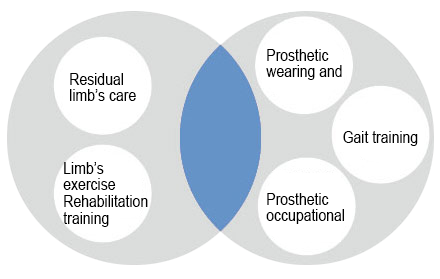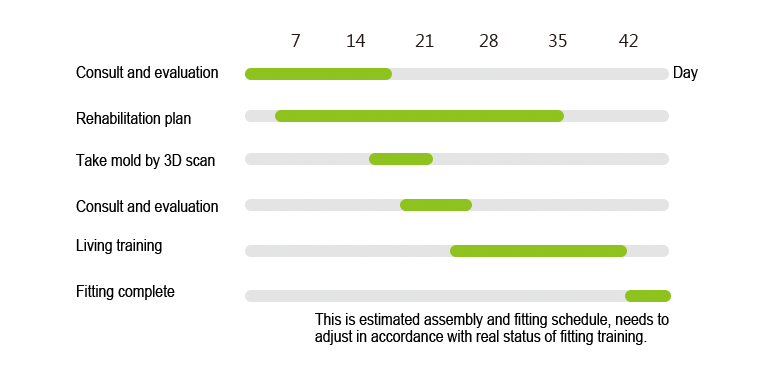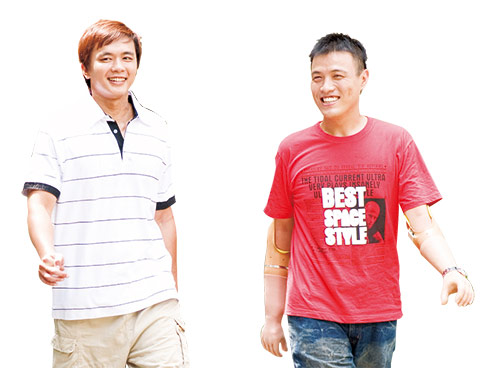UPPER LIMB PROSTHETIC REHABILITATION
UPPER LIMB PROSTHETIC REHABILITATION
On the human body the upper limb provides action for many important and precision activities in daily living. To help upper limb amputees return to a normal life TEH LIN’s upper limb prosthetic system integrates current clinical research and the latest advances in technology. TEH LIN's prosthetic system is provided to thousands of amputees throughout the Asia Pacific region every year. TEH LIN's extensive network of patient care facilities make it convenient to receive a prosthesis, as well as receiving any after sales support. It is very challenging for a patient when making the decision on where to receive a prosthesis, TEH LIN's experienced professional team will make this process easy, convenient, and will develop a rehabilitation plan designed for your specific needs and goals.
Rehabilitation training planRehabilitation training planUpper extremity amputation is usually the result of serious trauma. TEH LIN can provide the patient experienced and dedicated post-operative care that includes preparing the residual limb for prosthetic use and a specific rehabilitation plan to strengthen the remaining muscles and improve your range of motion. A successful rehabilitation outcome is determined by many factors. For the amputee who lost their limbs, rehabilitation is a cooperative team approach involving many people that are all committed to the amputee's success. Ideally, you will be the member of the team which includes family, friends, doctors, therapist, prosthetist, even a psychologist. Although the key person is the patient, every team member's profession and instruction is also very important. Not everyone can complete a comprehensive prosthetic rehabilitation plan, you can discuss the most effective arrangement with your prosthetist. The prosthetic rehabilitation process includes two portions: (1) The rehabilitation of the residual limb; (2) The functional training with the prosthesis. The rehabilitation of the residual limb can be separated into the physical therapy of the limb and Exercise Rehabilitation Therapy, abbreviated "ERT". ERT means that after putting on the prosthesis, the prosthetist will provide instruction on how to use the prosthesis appropriately and effectively. The prosthetist will help you make a suitable and effective rehabilitation plan with physical therapy, ERT, and the functional training with the prosthesis. |
Molding of the residual limb, modification, and fabrication of the socket
Molding of the residual limb, modification, and fabrication of the socket
Our experienced prosthetic technicians will carefully and deliberately measure and take a mold of your residual limb. Using plaster bandages the technician will carefully wrap your limb and once this hardens a negative mold will be created that is the exact size and shape of your limb. TEH LIN’s Central Socket Fabrication Center will use years of experience and advanced skills to create the most appropriate socket that will fit your limb precisely and comfortably. After the fabrication process is complete the prosthetist will fit you with a durable and beautiful socket.
When your residual limb and physical condition are suitable, TEH LIN’s prosthetic technicians can also use the newest globally available scanning technology to capture the shape of your residual limb. Using an advanced technology laser scanner to convert the shape of your residual limb into a 3D image for the computer and directly sending this to TEH LIN’s Central Socket Fabrication Center for modification of the digital model and fabrication of the socket. This system is very convenient, fast, and precise.
Once the patient begins using the prosthesis, the prosthetic technician will be an integral part of the training process. The first goal is to be able to put on and take off the prosthesis and properly position it for use. Once this is mastered, then the focus shifts to the control and operation of the prosthesis. This process will be different depending on if the prosthesis is body powered or uses an external power control system.
Prosthetic Life Training
Prosthetic Life Training
The rehabilitation process for an upper limb amputee is focused on strengthening the remaining muscles and improving the range of motion of the residual limb. Desensitizing the residual limb is also very important, due to the high number of sensory nerves in the upper extremity the residual limb can experience a “pins and needles” sensation or sometimes may even be painful. The prosthetic technician can use a number of methods to help control this over stimulation, including ultrasound, massage, electrical stimulation and resistance training. Also, during this time the patient will receive training with the remaining limb to better perform essential activities of daily living, such as eating, putting on clothes, using the toilet, grabbing and holding items, and writing.
Long-term rehabilitation therapy
Long-term rehabilitation therapy
We always encourage the patient to wear the prosthesis and learn how to use it for functions that make their life easier. For some individuals they may choose to wear the prosthesis only to perform certain functions or during a specific activity. Our goal is to make sure that you understand all of the possible options, and then can make your own decision about what would work best for you. Mastering more involved tasks requires a commitment and perseverance from the patient and it is important to keep in mind that once a person stops using a prosthesis it will be difficult to relearn and continue using in the future. Even if you are no longer wearing a prosthesis you can contact TEH LIN to reevaluate your condition and provide any assistance or recommendations.







